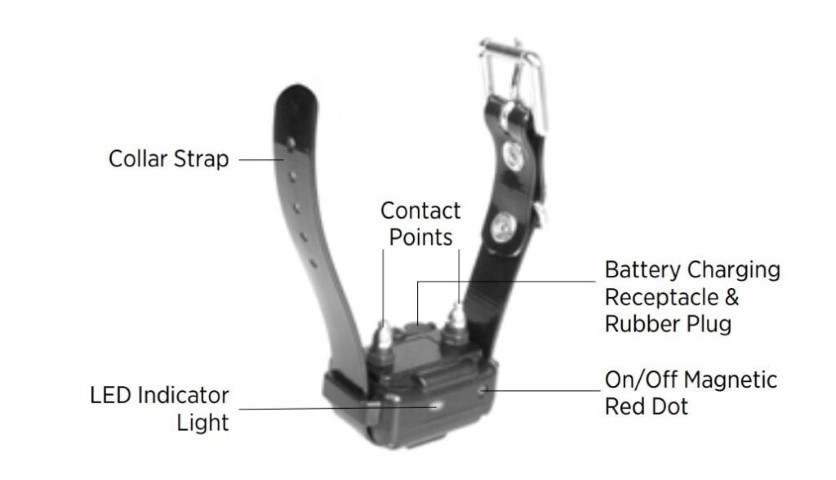Is it safe? Is it effective? Should I bother?
Shock collars are a controversial subject in the world of dog training. While some owners consider them an effective training tool, others argue that they are cruel and unnecessary.
The debate surrounding shock collars can be never-ending, and it can be difficult for pet owners to know what to believe. How do these collars work, and are they safe for our dogs?
In this article, we'll look at the controversy surrounding shock collars and answer the question on many dog owners' minds: will shock collar hurt my dog?
As an Amazon Associate, we earn from qualifying purchases
Understanding Shock Collars and Their Mechanism


Before discussing the potential effects of shock collars on dogs, it's important to understand their purpose and mechanics. Shock collars, also known as electronic collars or e-collars, are devices that deliver electrical stimulation to a dog's neck. These collars typically consist of a receiver worn around the neck and a remote control held by the trainer. The electric stimulation can range from a mild vibration to a stronger static shock, depending on the settings chosen by the trainer.
The shock collars are typically used to curb unwanted behaviors in dogs, such as excessive barking or aggression, by delivering a mild electric shock to the dog when they exhibit the behavior. The idea behind the shock is to create an unpleasant sensation for the dog that will discourage them from repeating the behavior.
Shock Collars and Dogs
The use of shock collars in dog training has become a widely debated topic, with many people expressing concerns about the detrimental effects it can have on a dog's well-being. But as per Dog Shock Collar Market Growth and Forecast till 2030 “the Dog Shock Collar market is projected to reach a multimillion USD size by 2028, compared to 2023, with an unexpected compound annual growth rate (CAGR) during the forecast period of 2023-2028”.
Shock collars for dogs are considered cruelty to animals in many countries, but shock collars are legal in the USA. They are mainly used for training, tracking, or monitoring the dogs. Based on their role and specific need, these collars can be further categorized as GPS Based or Radio Based.
Overview of Dog Behavior


Dog behavior is a complex and multifaceted subject that requires careful study and observation. Understanding the behavior of dogs is essential for building strong, positive relationships with them, as well as for addressing any problematic behaviors they may exhibit. Dogs are social animals that are highly attuned to their environment, and they communicate using a range of vocalizations, body language, and other forms of behavior.
Some of the most important elements of dog behavior include aggression, fear, anxiety, playfulness, and sociability. Additionally, dogs can display a wide variety of species-specific behaviors, including scent marking, digging, chewing, and hunting. A thorough understanding of dog behavior is essential for anyone who wants to work with dogs in any capacity.
Impact of Shock Collars on Dog Behavior
The impacts of shock collars on a dog's behavior include inducing fear and anxiety, exacerbating aggressive behavior, and inflicting physical and psychological harm. Furthermore, shock collars can create a negative association between the owner, the environment, and the training experience, leading to distrust and avoidance behaviors.
Risks of Using Shock Collars
While shock collars have their proponents, it's important to consider the potential risks and concerns associated with their use. These collars may seem like a quick fix for behavioral issues, they come with a host of potential risks and negative consequences.
Physical risks associated with shock collars
- Skin Irritation and Burns: The contact points on the shock collar, which deliver the electric stimulation, can cause skin irritation or burns if the collar is worn for extended periods or if it is too tight. It's crucial to regularly inspect the dog's neck and ensure that the collar fits properly to prevent discomfort or injury.
- Muscle or Nerve Stimulation: In some cases, shock collars may stimulate the muscles or nerves of the dog, leading to involuntary muscle contractions or twitches. This can be distressing for the dog and may cause discomfort.
- Risk of Physical Trauma: In rare instances, the use of shock collars has been associated with physical trauma. Dogs who are highly sensitive or reactive may exhibit panic or fear responses when exposed to electric shocks, potentially leading to accidents or injuries.
- Adverse Effects on Health and Well-being: While the severity of the physical risks can vary, it's important to recognize that the use of shock collars can have an impact on a dog's overall health and well-being. Prolonged exposure to aversive stimuli may lead to chronic stress, anxiety, or other behavioral issues.
Emotional and psychological risks
- Fear and Anxiety: Electric shocks delivered by shock collars can instill fear and anxiety in dogs. The aversive nature of the shocks can create a stressful environment, causing dogs to associate training sessions with unpleasant experiences. This fear and anxiety can have long-lasting effects on the dog's emotional well-being.
- Trust and Bonding Issues: The use of shock collars can erode the trust between a dog and its owner. Dogs may perceive their owners as the source of discomfort and pain when wearing the collar, leading to a breakdown in trust and a strained relationship. This can hinder effective communication and hinder the bonding process.
- Learned Helplessness: Dogs exposed to repetitive and aversive electric shocks may develop a state of learned helplessness. They learn that their actions have no effect on avoiding the shocks, leading to a sense of resignation and passivity. This can impact their overall motivation, engagement, and ability to learn.
- Aggression and Reactivity: Some dogs may display aggression or heightened reactivity as a response to the stress and confusion caused by shock collar usage. The use of aversive techniques can trigger defensive behaviors, increasing the risk of aggressive displays towards people, animals, or specific situations.
- Depression and Avoidance Behaviors: Dogs subjected to shock collar training may exhibit signs of depression or avoidance behaviors. They may become withdrawn, exhibit decreased interest in activities, and avoid training sessions altogether. These emotional responses can negatively impact the dog's quality of life and overall happiness
Will Shock Collar Hurt My Dog?


The shocking truth is that these shock collars can actually hurt dogs and cause them distress. It is essential to note that the use of a shock collar can lead to serious health issues that can harm your dog's physical and psychological state. While proponents might suggest that shock collar training can be effective and humane, the reality is that it can often do more harm than good.
It is imperative to utilize humane and positive reinforcement methods in dog training, as opposed to using tools that have the potential to hurt your dog. In conclusion, it is essential to ask yourself whether the benefits of using shock collars outweigh the potential risks to your dog's well-being before choosing to use them.
Having said all this, but still, if you are interested to use a shock collar on your dog, then follow these tips.
How to Use Shock Collars on Dogs Safely
Educate Yourself
Before using a shock collar, educate yourself about its proper usage, potential risks, and training techniques. Familiarize yourself with the collar's features, such as intensity levels and modes, and understand how to adjust them appropriately.
Seek Professional Guidance
Consult with a professional dog trainer or behaviorist who has experience with shock collar usage. They can provide valuable insights, guide you through the training process, and help ensure the safety and well-being of your dog.
Choose the Right Collar
Select a shock collar that is specifically designed for your dog's size, breed, and temperament. Ensure that the collar fits comfortably and securely, without causing any discomfort or restricting the dog's movement.
Start with Low Intensity
Begin with the lowest intensity setting on the shock collar. Gradually increase the intensity only if necessary and if you observe a minimal response from your dog. Avoid using high levels of stimulation unnecessarily, as it can cause distress or harm to your dog.
Limit Usage and Duration
Use the shock collar only during training sessions and avoid prolonged or continuous use. Limit the duration of each training session to prevent overexposure to the aversive stimuli. Regular breaks and positive reinforcement intervals can help create a more balanced and positive training experience.
Monitor Your Dog's Response
Pay close attention to your dog's reactions and behavior during training sessions. Observe for signs of stress, anxiety, or discomfort, such as excessive panting, trembling, or avoidance behaviors. If your dog shows distress, stop using the shock collar immediately and reassess your training approach.
Pair Shock with Positive Reinforcement
Whenever you deliver a mild shock, always follow it with positive reinforcement, such as treats, praise, or playtime. This helps your dog associate the shock with a desired behavior and reinforces positive training.
Regularly Assess Progress
Continuously monitor your dog's progress and behavior throughout the training process. Regularly assess if the shock collar is helping achieve the desired results and if it remains an appropriate training tool for your dog's specific needs.
Conclusion
In conclusion, the use of shock collars can indeed hurt dogs and cause them distress. It is advisable to opt for humane and positive reinforcement methods in dog training to ensure the well-being of our furry friends.
Frequently Asked Questions About Will Shock Collar Hurt My Dog?
What is a shock collar?
A shock collar, also known as an electronic collar or e-collar, is a training device that uses static shock to modify a dog's behavior.
Do shock collars hurt dogs?
The level of shock provided by shock collars can vary depending on the brand and settings. While many dog owners and trainers swear by shock collars as a training method, some studies have suggested that they can cause unnecessary harm to dogs.
How do shock collars work?
Shock collars work by sending a controlled stimulus to a dog's neck through metal contact points on the collar. This stimulus can range from a mild vibration to a strong, static shock. The idea is that the dog will learn to associate the sensation with a specific behavior and eventually stop displaying that behavior.
What are some reasons someone might use a shock collar?
Shock collars can be used to stop a dog from barking excessively, to train a dog to stay within a certain area, and to prevent dogs from engaging in certain undesirable behaviors like jumping on furniture or digging in the yard.
Are shock collars the only way to train a dog?
No, there are many dog training methods available, including positive reinforcement techniques like clicker training and treat-based training. These methods are generally considered more humane than aversive training techniques like shock collars.
Can shock collars be used as a humane way to train a dog?
Opinions on this vary. While some dog owners and trainers argue that shock collars can be a humane and effective training tool when used properly, others believe that they cause unnecessary harm to dogs and should not be used.
Are there any risks associated with using shock collars?
Some studies have suggested that shock collars can cause undue stress and anxiety in dogs, and may even lead to aggressive behavior. Additionally, if not used properly, shock collars can cause physical injury to a dog's neck.
How do I know if a shock collar is right for my dog?
If you are considering using a shock collar to train your dog, it's important to research the pros and cons carefully and talk to your veterinarian or a professional dog trainer before making a decision.
Will shock collars kill my dog?
The use of shock collars on dogs can cause physical and psychological harm, but it is unlikely to kill your dog.
Can a shock collar cause permanent damage?
Yes, a shock collar can cause permanent damage to a dog including muscle damage, thyroid damage, neck injuries, eye, and ear damage.
Can a shock collar traumatize a dog?
Using a shock collar on a dog can potentially traumatize them. The electric shocks delivered through the collar can cause physical pain and discomfort, which could lead to fear or anxiety. Furthermore, the repeated use of a shock collar can create negative associations with certain behaviors, causing the dog to become anxious or aggressive when confronted with similar situations.
Do shock collars have long-term effects?
The long-term effects of shock collars on dogs are still unclear. Some studies suggest that it can lead to fear, anxiety, and aggression in dogs. It also has the potential to damage the relationship between the pet owner and the pet. It is important to consider other training methods that are more humane and effective.
Do veterinarians recommend shock collars?
Many veterinarians do not recommend shock collars as they can cause physical and psychological harm to pets. The use of positive reinforcement techniques such as treats and praise are preferred and can be just as effective in training pets. It is important to consult with a veterinarian or a certified trainer to determine the best training approach for your pet.
Can a shock collar hurt a dog's brain?
There is no evidence of a shock collar causing brain damage to dogs. However, it can cause physical pain and emotional distress, leading to long-term behavioral issues. It's important to seek alternative training methods that rely on positive reinforcement to avoid potential harm to your pet.
Can a shock collar damage a dog's vocal cords?
Using a shock collar on a dog can potentially damage its vocal cords. The use of shock collars is controversial and has been banned in some countries. Positive reinforcement training methods are a safer and more effective way to train your dog.
Can a shock collar paralyze a dog?
It is very unlikely for a shock collar to paralyze a dog. While the electrical impulse may be uncomfortable or painful, it is not strong enough to cause paralysis. However, shock collars can cause physical and psychological harm to dogs if used improperly or excessively. It is important to thoroughly research and consider alternative training methods before using a shock collar.
Can you use a shock collar on a puppy?
While some people may argue that shock collars are effective training tools, they are not recommended for use on puppies. Puppies are still developing physically and mentally, and the use of shock collars can cause unnecessary stress and potential harm to their health. Positive reinforcement training methods are the most effective and humane approach to teaching puppies appropriate behavior.
You may like to read more about shock collars:-
- 10 Safest Shock Collars For Dogs – The Simple, Easy Guide
- Do Shock Collars Hurt Dogs?- Dog Collars, Shock Collars and Training Tools: FAQs
- 14 Amazing Benefits Of A Shock Collar For Dogs
- 10 Ultimate Strongest Shock Collars For Dogs That Work Even Without A Trainer
- Shock Collar Burn Treatment: 7 Effective Natural Ways to Get Rid of Your Dog’s Pain





